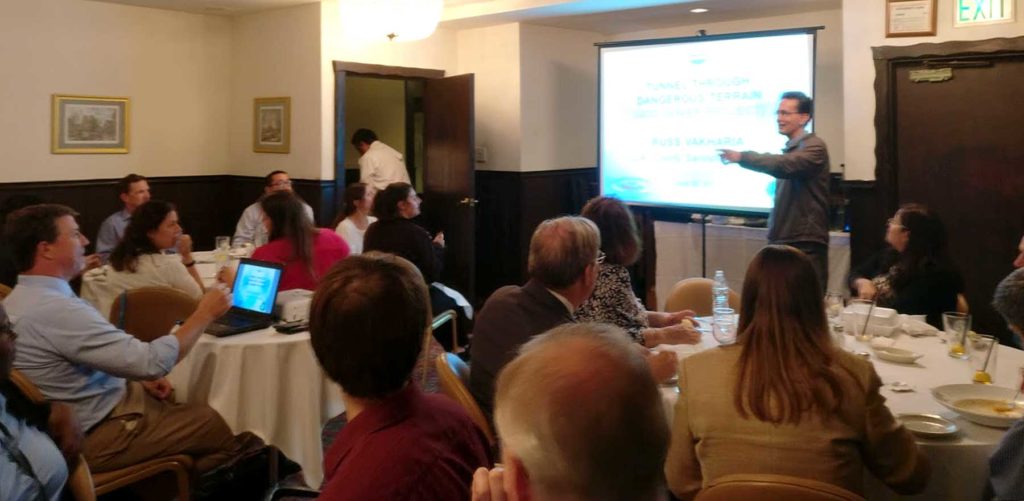At the June 29, 2017 LABS dinner meeting, Russ Vakharia of the Los Angeles County Sanitation Districts (LACSD) gave a presentation on the construction of a 7.5-foot inside diameter (ID) replacement sewer in metropolitan Los Angeles County.
The talk highlighted the many challenges encountered during the construction, including tunneling under public and private property, tunneling under an active refinery, encountering contaminated soil and squeezing ground, encountering explosive gas, keeping the effected public and businesses informed while satisfying their requests, and tying into an active sewer.
The new sewer was a 2.5-mile stretch of a main artery to LACSD’s Joint Water Pollution Control Plant running from an oil storage facility east of the intersection of Alameda Blvd. and Lomita Blvd. in Wilmington, CA to the intersection of Main St. and Lomita Blvd. in Carson, CA. The construction was performed in two phases, and each phase was a separately bid contract. Coincidently, the same general contractor was awarded both contracts.
The first contract cost approximately $17 million and was for construction from the western end (intersection of Lomita Blvd. and Main St.) to approximately one mile east to Wilmington Blvd and was strictly under Lomita Blvd.

Engineer Russ Vakharia explains LACSD’s complex tunneling project to fellow engineers at a LABS dinner meeting.
The second contract cost approximately $31 million, was more complicated than the first contract and was for construction from the end of the first contract to the eastern connection point with the existing sewer. The second contract construction was under public and private property as well as multiple railroads. Many of the private properties were oil refineries, oil storage yards and other heavy industries with many buried pipelines. Some buried pipelines were identified on pre-construction drawings and some were first encountered during the construction. Many pipeline relocations were required, and each relocation had to be addressed in a manner approved by the pipeline owner, typically an oil refinery or utility.
The tunnel was 12-foot diameter and was constructed using an older (and much less costly) tunnel boring machine consisting of a front-end shovel that scooped dug earth onto a conveyor. The conveyor discharged the dirt at the back of the machine to rectangular buckets that were transported by rail out of the tunnel. Then steel rings (ribs) were erected every 5 feet, for tunnel structure support and wooden panels were installed between the rings (wood lagging).
Once the tunnel was formed, sections of plastic-lined, corrosion resistant 7.5-foot ID concrete pipeline were installed. The sewer pipe sections were double-gasketed and fabricated to connect to one another, forming a continuous smooth pipe surface.
Two specific hazards encountered during the construction were highlighted. The first hazard was when a pocket of gasoline contaminated soil and explosive vapor was encountered during the tunneling. For safety, OSHA was notified and OSHA required remedial action. All underground mechanical and electrical equipment was upgraded using explosion proof electrical fittings and controllers, the construction crew was trained to work in explosive environments, and the tunnel was continually monitored for vapors.
The second hazardous event was when black liquid seeped through the tunnel’s wooden lagging and some of the tunnel lagging began to crack from external stresses. A steel liner was installed inside the wood lagging to seal it from further seepage and to provide structural support. Other issues encountered included a realignment of the sewer under Lomita Blvd to avoid impacting the entrance of a local shopping center. When completed, the new sewer was tied into the existing sewer while it was flowing. This required the construction of a watertight box around the existing sewer and then cutting out the section of sewer within the box, and tying it into the new sewer.
Planning the sewer replacement took approximately eight years and executing the two construction contracts took over three years.